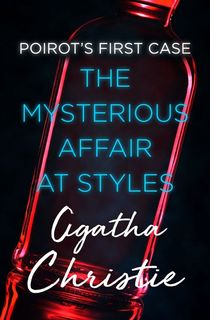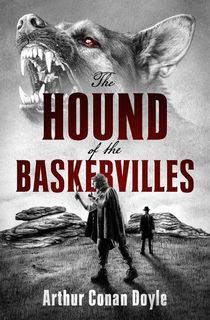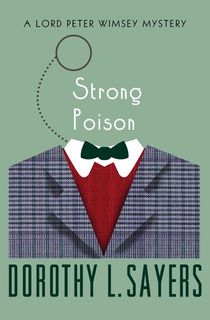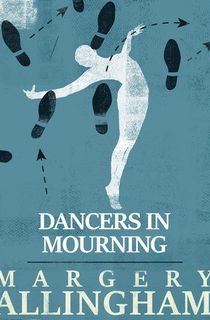Sinister suspects, brilliant sleuths, a mystifying case just waiting to be cracked. The thrill of a great detective tale is undeniable. And while there are plenty of modern-day mysteries vying for your attention, sometimes you want to go back to where it all began. That’s why we rounded up nine classic detective fiction novels that every mystery fan needs to read. From the debut novel by the Queen of Crime Agatha Christie to the early works of the dean of hard-boiled detective fiction Dashiell Hammett, these legendary whodunits deserve your attention.

The Mysterious Affair at Styles
Agatha Christie crafted some of the most influential crime fiction novels of all time, inspiring legions of readers and laying the groundwork for the modern detective tale. The undisputed Queen of Crime published over 60 crime novels throughout her decades-long career, many of which feature her beloved amateur sleuth Miss Marple or the brilliant Belgian detective Hercule Poirot. A Mysterious Affair at Styles, Christie’s first published novel from 1920 and the first to feature Poirot, is where it all began. The moustachioed man with an astonishing capacity for cracking cases sets about solving the poisoning death of Emily Inglethorp, matriarch of a country manor known as Styles Court. While the houseguests of the manor point fingers and cast suspicion, Poirot goes to work, assessing the evidence and tracking the clues until he finds the killer.

The Hound of the Baskervilles
Sir Arthur Conan Doyle penned a number of successful Sherlock Holmes narratives between 1887 and 1893. In fact, the author’s literary creation became so popular that Doyle grew tired of writing about him; in 1893, he killed off the sleuth in the short story "The Final Problem." Readers were devastated by the development, and their sustained demand for Sherlock’s return inspired Doyle to resurrect the good detective in 1903’s The Hound of the Baskervilles. Set before the events of "The Final Problem," Baskervilles is a smartly crafted mystery mixed with gothic chills. A monstrous beast is said to haunt the grounds of Baskerville Hall, leaving victims in its wake. The latest is Sir Charles Baskerville. Strange footprints were found near the body and the victim’s face was twisted in terror. Holmes and his associate Dr. Watson set out to solve the eerie mystery and track down the villainous force stalking the Baskerville clan. The Hound of the Baskervilles was welcomed with open arms by Holmes devotees upon its publication in 1903 and remains one of Doyle’s most famous works. Ruth Rendell toasted the tale and its lasting influence in a 2008 article for The Guardian, describing it as "one of the most famous stories ever written."

The Moonstone
With its intricate plotting, crowded cast of suspects, and baffling caper packed with clues and red herrings, Wilkie Collins’ The Moonstone, published in 1868, is widely regarded as one of literature’s first detective novels. A glittering diamond with a very dark past ends up in the hands of young Rachel Verinder. When the gemstone is stolen during Rachel’s 18th birthday celebration, it sets off a deadly game of detection. Readers curious about the beginnings of detective fiction should also check out Edgar Allan Poe’s 1841 tale "The Murders in the Rue Morgue," found in The Complete Short Stories, and Mary Elizabeth Braddon’s 1860 crime drama The Trail of the Serpent.

Strong Poison
Dorothy L. Sayers was a founding member of London’s famed Detection Club and a premier scribe of the Golden Age of Detective Fiction. Strong Poison, published in 1930, is the author’s fifth to feature her gentleman detective Lord Peter Wimsey and is viewed as one of the author’s finest mysteries. All of London is transfixed by a murder case involving Harriet Vane. Vane, a mystery author, stands accused of poisoning her old lover Phillip Boyes, a writer who held radical views on politics and free love. Wimsey closely observes the proceedings. Soon, he’s not only convinced of Vane’s innocence, but suspects he’s falling in love with her as well. Now he’s in a race to identify the true culprit and clear Vane’s name before she meets the hangman’s noose.
Related: 10 Modern and Classic Mysteries for Dorothy L. Sayers Fans

Dancers in Mourning
Margery Allingham’s mysteries featuring gentleman detective Albert Campion initially drew comparisons to Sayers’ Wimsey novels. Allingham soon broke free from such comparisons, however, rising to become one of the most versatile authors of the Golden Age of Detective Fiction. Dancers in Mourning, first published in 1937, is the author’s eighth novel to feature Albert Campion. Someone is playing pranks on entertainer Jimmy Sutane, causing a great deal of stress for the music hall performer as he rehearses his latest show. Campion is tasked with finding the prankster when the backstage mischief takes a deadly turn. An aging starlet in Sutane’s orbit turns up dead. The death appears accidental, but Campion suspects otherwise. Can the gentleman detective solve this mystery before the stage lights go out for good? Fans of Campion should next check out 1952’s The Tiger in the Smoke, which finds the sleuth searching for a killer through the foggy streets of London. In 2014, J.K. Rowling expressed her admiration for Allingham’s work and praised The Tiger in the Smoke as a "phenomenal novel."
Related: Queen of Crime: Margery Allingham's Mystery Novels Still Hook Us Today

The Adventures of Ellery Queen
Ellery Queen was the pseudonym of Frederic Dannay and Manfred Bennington Lee, two cousins from Brooklyn who together created one of the most popular sleuths in American crime fiction. The series follows Ellery Queen, a superb amateur detective from New York who joins forces with his law enforcement father, Inspector Richard Queen, to solve baffling crimes. A key appeal of the Queen series when it debuted in 1929 was its dedication to fair play construction. Readers received the same clues as Ellery, and the cleverest among them could in theory crack the case right alongside the fictional sleuth. The Adventures of Ellery Queen, published in 1934, collects 11 Queen mysteries, and finds the crime-solving protagonist crossing paths with a wild cast of thugs, thieves, and assassins.

The Giant Collection of the Continental Op
The Boston Globe hailed Dashiell Hammett as a "master of the detective novel" and it’s easy to see why. The American author created a number of the genre’s most enduring sleuths, including Nick and Nora Charles and world-weary P.I. Sam Spade. And while The Thin Man and The Maltese Falcon are both essential reads, we’re training our sights on Hammett’s pioneering Continental Op stories. Inspired by the author’s own experiences as a Pinkerton detective, the Continental Op stories follow an unnamed private investigator of San Francisco’s Continental Detective Agency. The gritty tales of corruption and murder are delivered in a bracing first-person perspective—and together set the pitch-black blueprint for modern American detective fiction. This essential volume collects 23 Continental Op stories published between 1923 and 1930, and is a must-own for mystery enthusiasts.
Related: The Thin Man: How Dashiell Hammett’s Life as a Private Eye Inspired his Crime Fiction Classics

The Big Sleep
Along with Hammett and James M. Cain, Raymond Chandler was a defining figure of the hard-boiled school of American crime fiction. The Big Sleep, published in 1939, is Chandler’s first novel and the first to feature his hard-drinking detective Philip Marlowe. General Sternwood, an elderly wealthy man in Los Angeles, calls on Marlowe to help with an indelicate family situation. It seems a bookseller named Arthur Geiger is attempting to blackmail concerning Sternwood’s troublesome young daughter, Carmen. Marlowe accepts the case, only to find himself ensnared in a web of deceit and double-dealing that stretches across Los Angeles. The Big Sleep was twice adapted for the silver screen—first in 1946 starring Humphrey Bogart and again in 1978 starring Robert Mitchum The Cohen Brothers’ The Big Lebowski is also inspired by Chandler’s hard-boiled literary style. In 2005, TIME listed The Big Sleep on its list of the 100 best novels. All those curious about the man behind the mystery should check out The Raymond Chandler Papers, which collects letters and early writings of the influential author.

The Daughter of Time
Born Elizabeth MacKintosh, Scottish author Josephine Tey published six mysteries featuring Scotland Yard Inspector Alan Grant before her untimely death of cancer in 1952. While Tey began publishing during the Golden Age of Detective Fiction, her modernist sensibilities and increased attention to the inner lives of her characters were a bold departure from the expectations of the Detection Club, and paved the way for the contemporary crime novel. The Daughter of Time, published in 1951, stands as the author’s most popular mystery work. Inspector Grant is laid up in the hospital and recuperating from a broken leg. With nothing but time on his hands, he begins investigating a mysterious case from England’s past: Richard III, reputed royal villain and presumed murderer of his nephews Edward and Richard, better known as the Princes in the Tower. Was Richard truly the scheming and homicidal hunchback so often depicted in history and literature? With the help of his friends, including an American researcher at the British Museum, Grant scours the past in search of the truth behind Richard III and the deaths of the Princes in the Tower. The Daughter of Time was a critical success upon its release. In 1990, the British Crime Writers Association named it the best crime novel of all time.
This post is sponsored by Open Road Media. Thank you for supporting our partners, who make it possible for Murder & Mayhem to continue publishing the mystery stories you love.


